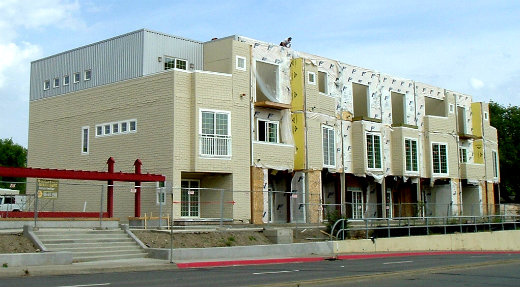Read an excerpt from this article below. You can download the full article by using the link at the end of the excerpt.
Slowly, communities across the nation are coming to realize that manufactured housing is not just a gussied-up term for trailers. Instead, manufactured housing has become a catch-all phrase for any dwelling at least partially built in a factory, as opposed to “traditional” housing entirely assembled at the home site.
The industry still builds that familiar “mobile home” on a chassis with wheels, but these now represent a shrinking portion of the market, and even these rarely wear those wheels permanently. Instead, esthetic concerns have pushed the industry to turn mobile homes into conventional dwellings that are really only “mobile” while being delivered to the building site.

California. Built by Karsten Homes, these manufactured townhomes are selling
at market rate, with starting prices of $329,000 for a 1,475 square foot home.
“Manufactured housing” today simply means any home built according to rigid federal standards that reformed the mobile home industry in 1976. Called the HUD Code, these standards so increased the quality of mobile homes that the industry became competitive with conventional housing, and began to produce ready-made homes almost indistinguishable from traditional stick-built housing.
The industry has even gone back to its roots. The broader category of factory-built housing now includes kit homes with cutting-edge architecture that follow the path originally defined by the Sears catalog kit home, which first sold for $945 in 1908 (later versions sold for as little as $373).
Manufactured homes are now almost always installed on permanent foundations. Homeowners often choose a manufactured home for their residential lot — whether rural or urban — because it is faster and easier to build, and less costly. See Sidebar, The Housing Ladder. With a shorter build time, delays caused by labor availability and weather are minimized.
“The homes themselves are able to blend in anywhere,” said Thayer Long, assistant vice president of the Manufactured Housing Institute, the chief industry trade group. “People are realizing the quality is just the same as a site-built home. In some cases, it’s better. And you can get it any way you want it now.”
The quality and diversity of today’s manufactured housing is throwing traditional definitions out the window. An unfortunate consequence is that many local governments are more puzzled than ever about how to handle this increasingly popular housing sector. …
End of excerpt
You must be logged in or a PlannersWeb member to download this PDF.